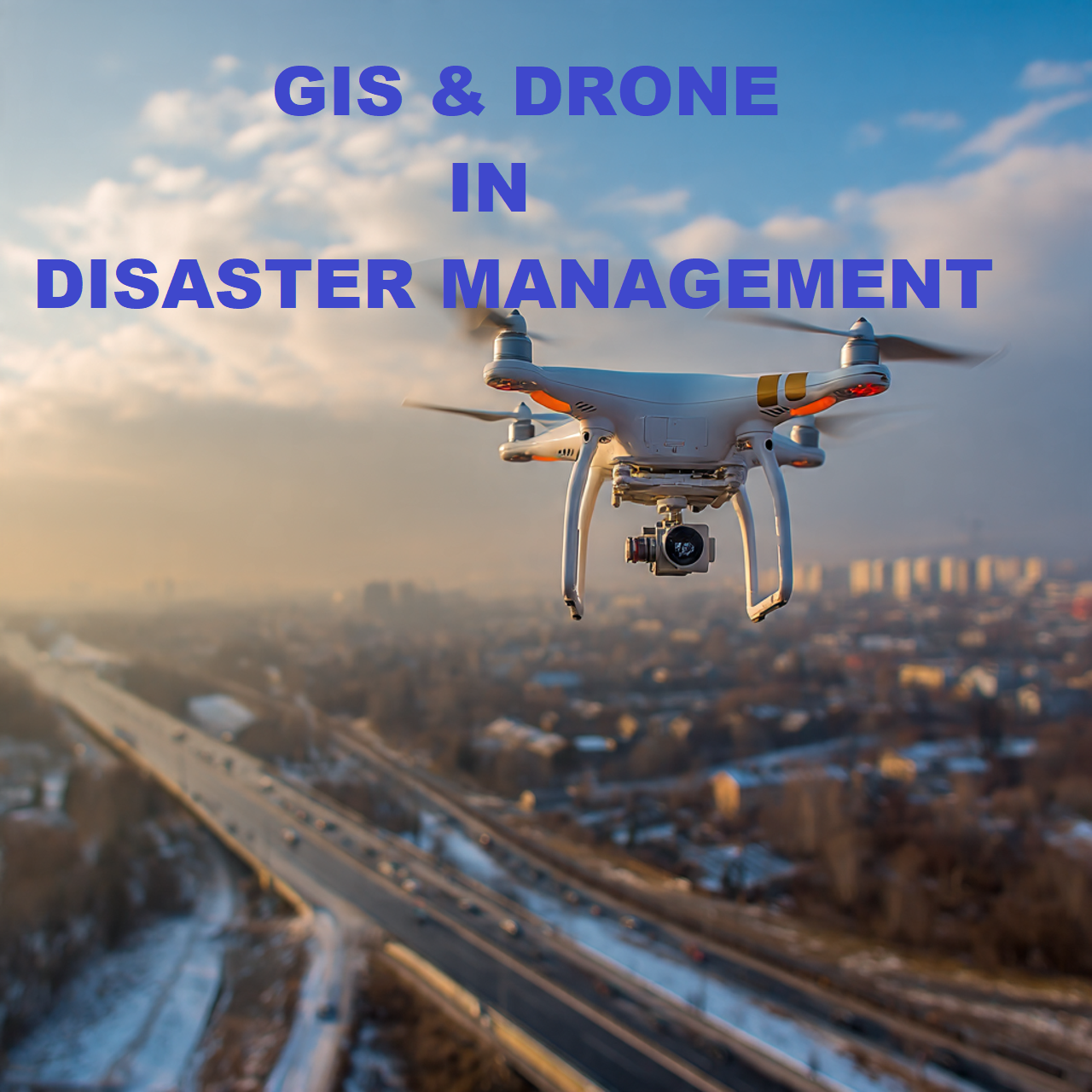GIS and Drones in Disaster Management
GIS and Drones in Disaster Management is the new topic on which we are going to work today. As you all are aware that Disasters attack unexpectedly. Hence, individuals need always to be ready with efficient measures. Here, technology comes in to play a crucial role in preventing loss of life and mitigating the effects. Additionally, advanced tools such as GIS, drones, and cell phone apps revolutionize how communities respond to emergencies.
To begin with, GIS assists in identifying areas prone to disasters, and subsequently, authorities can adequately organize evacuation paths. Then, drones give rapid aerial assessments, and therefore, rescue parties access victims quickly. In addition, mobile apps link citizens with the government in an instant, and therefore, communication is enhanced when there is a crisis.
Moreover, these technologies not only make disaster response faster but enhance the process of recovery. For instance, the provision of real-time data informs decision-making, while, at the same time, guesswork decreases. Therefore, through integration of these online tools, disaster management projects are made more efficient, effective, and innovative. In the end, students have to investigate such projects, as they show how potent technology is in saving communities.
GIS and Drones in Disaster Management
Introduction of the Topic
Disasters touch millions of lives across the globe; thus, societies have to implement smart solutions to reduce their impact.
To this end, technology has an important role in enhancing disaster management systems.
To begin with, it makes people better prepared through accurate forecasts, and hence, communities can undertake preventive actions in a timely manner.
Also, digital technologies like satellite imagery, sensors, and GIS mapping enable authorities to detect vulnerable areas at a rapid pace.
Then, communication tools such as social media and mobile apps make sure that people receive warnings instantly and, thereby, lives are saved.
Additionally, advanced devices like drones aid rescue forces by scanning the areas that are destroyed and finding victims effectively.
Also, artificial intelligence and big data inform decision-making as they recognize patterns and forecast threats.
Therefore, technology not only enhances the efficiency of responding to disasters but also enhances efforts to recover.
Finally, through adopting latest advances, people can create resilience as well as minimize the destructive impact of disasters.
What Is GIS and Why Is It Important in Disaster Preparedness?
Geographic Information System (GIS) is a strong tool that gathers, analyzes, and presents spatial information;
hence it plays an essential role in disaster preparedness.
To begin with, GIS assists in the identification of disaster-vulnerable areas by the authorities, thus they are able to plan ahead for interventions.
Additionally, it enables specialists to develop hazard maps pointing out flood-prone areas, earthquake fault lines, and cyclone tracks.
Then, emergency planners utilize GIS to plan safe evacuation roads, and as a result, individuals can run away quickly during emergencies.
Additionally, GIS incorporates up-to-the-minute weather and satellite imagery, and therefore, authorities can track changing situations correctly.
Besides, it facilitates the allocation of resources by indicating where shelters, hospitals, and relief camps need to be established.
Therefore, GIS not only offers vivid visualizations but also enhances decision-making.
Finally, through the application of GIS in disaster planning, communities are able to minimize risks, respond properly, and recover faster following natural
How to apply GIS in Hazard Mapping and Risk Assessment?
GIS is a key component in the hazard mapping and risk assessment; as such, it is a critical tool used in disaster management initiatives.
To begin with, GIS gathers environmental and spatial data, and thus, authorities are able to determine areas prone to floods, landslides, or cyclones.
Furthermore, it imposes several layers of information—population density, infrastructure, and topography—and therefore, it identifies better risks.
Secondly, specialists utilize GIS to model disaster situations, and thus they are able to pilot preparedness measures prior to real disasters.
Thirdly, hazard maps created by GIS inform urban planners on how to zone safe places for development and simultaneously limit building in risk-prone areas.
Fourthly, such maps inform policymakers on how to distribute resources as they identify the most risk-prone communities.
Thus, GIS applications not only enhance disaster planning but also enhance early warning systems, rendering societies safer and more resilient.
Drones Support in Emergency Response Operations
Drones have transformed the work of emergency response operations; thus, they are a key part of contemporary disaster management.
For starters, drones move faster over disaster areas, and therefore rescue teams receive immediate aerial information about the situation.
In addition, drones take high-quality images and videos, and thus officials can evaluate damages without endangering human lives.
Then, they provide necessary materials like food, water, and medicines to stranded victims, and at the same time, they observe inaccessible areas
effectively.
Besides, drones help identify missing individuals through thermal cameras, and as a result, search operations are quicker and more precise.
In addition, these tools aid in observing environmental changes such as increasing floodwaters or the progression of wildfires, and accordingly,
authorities can make prompt decisions.
Thus, incorporating drones into emergency response, disaster management teams increase speed, safety, and efficiency,
ultimately saving more lives and minimizing property loss.
Use of Drones in Rescue and Relief Efforts
Drones have become irreplaceable in rescue and relief efforts; hence, they greatly improve disaster response.
Secondly, drones give immediate aerial images, and as such, rescue personnel can easily identify stuck or injured victims.
Additionally, they distribute emergency aid like medication, food, and water, and thus reach remote locations inaccessible by roads or vehicles.
Then, drones with thermal and infrared imagery aid in locating survivors during nighttime missions, and simultaneously,
they also track environmental dangers such as fires or floods.
In addition,
drones aid in surveying affected infrastructure, and therefore, relief distribution can be prioritized effectively.
Additionally,
they aid in communication networks by serving as temporary signal repeaters, and therefore, team coordination is significantly enhanced.
Therefore, incorporating drones in rescue and relief operations not only speeds response but also minimizes risks for human responders, ultimately saving
more lives in the event of disasters.
The Growing Role of Mobile Apps
Mobile applications have a more critical role in disaster communication; thus, they improve response and preparation activities.
To start with,
applications send real-time messages regarding floods, cyclones, earthquakes, and other emergencies, and thus, the public gets timely warnings.
Furthermore, they facilitate two-way communication, and thus, individuals can report cases or seek assistance immediately.
Secondly, applications have GPS location tracking and sharing, and therefore, rescue teams can easily find stranded or injured persons.
Thirdly, most apps provide guides to disaster preparedness, checklists, and safety advice, and concurrently, they inform communities on reducing risk.
Fourthly, mobile applications combine social media updates and local government alerts, and thus, authorities can better coordinate with citizens.
Thus, through the utilization of mobile applications, disaster communication gets expedited, reliable, and efficient,
ultimately saving lives and enhancing overall emergency response mechanisms.
Best Mobile App Features for Disaster Management Projects
Mobile applications enhance disaster management initiatives.
It provides critical functionalities that boost readiness and response; thus, creating good apps is important.
To start, instant alerts inform individuals of incoming dangers, and thus communities are able to initiate protective actions instantly.
Additionally, GPS location and tracking assist rescue units in locating stranded victims, and thus response time reduces remarkably.
Then, interactive checklists and safety guides inform people about preparing themselves for disasters, and simultaneously,
they raise awareness among the community.
Additionally,
two-way communication systems enable users to alert authorities in case of emergencies and seek help immediately, and therefore,
coordination becomes easier between governments and people.
Also, integrating with social media and government alerts ensures that updates are communicated to more people, and as such,
lives can be saved to a greater extent.
Thus, integrating these aspects makes mobile applications extremely efficient, trustworthy, and essential tools in disaster management initiatives.
Case Studies: Examples of Successful Use of GIS, Drones, and Apps
Numerous nations have employed GIS, drones, and mobile applications successfully to coordinate disasters efficiently;
hence,
these case studies are of great learning.
To start with,
in the 2015 Nepal earthquake, GIS mapping assisted officials in mapping the worst-hit areas, and rescue efforts arrived at critical areas more quickly.
Subsequently,
in the 2018 Kerala floods, drones mapped flooded areas, and thus, rescue groups were able to find stranded families and distribute critical supplies
effectively.
Then, in the pandemic era of COVID-19, mobile applications such as Aarogya Setu
in India monitored hotspots of infections, and simultaneously, the citizens were being informed through real-time alerts to stay away from high-risk areas.
Additionally, in Japan,
the integration of GIS, drones, and mobile apps during typhoon season facilitated authorities to model the disasters and hence enhanced evacuation plans
and fewer casualties.
Furthermore,
the technologies improved communication between government authorities and the public, and thus response and recovery operations were better coordinated and efficient.
Therefore, the case studies illustrate that incorporating GIS, drones, and mobile applications can save lives and reduce loss of property in the event of disasters.
Challenges in Using Technology for Disaster Management
To begin with, excessive expenses restrict the deployment of sophisticated technologies such as drones and GIS systems, and therefore, most organizations find it challenging to adopt them.
Secondly, limited technical skills hinder groups from harnessing these technologies, and therefore, productivity reduces.
Thirdly, poor internet and communication networks interfere with live data sharing, and hence, prompt decisions are not possible.
Finally, the integration of multiple technologies creates compatibility problems, and simultaneously, coordination is made more complex.
In addition, privacy issues related to data limit the gathering and application of sensitive data, and thus, the authorities have to adhere to strict procedures.
Limited battery life and operational limitations undermine the efficiency of drones during prolonged rescue operations, and thus, coverage is compromised.
Dynamic disaster situations make it challenging to keep technological tools current, and as a result, projections can be inaccurate.
Social resistance and ignorance hamper participation, and thus, the influence of technology is diluted.
Regulatory and legal hurdles slow down the deployment of new solutions, and simultaneously hinder experimentation.
Lastly, maintenance and technical problems can sabotage operations, and hence backup plans are still vital to secure easy disaster management.
Conclusion: GIS and Drones in Disaster Management
Technology revolutionizes disaster management projects; hence, the inclusion of GIS, drones, and mobile applications makes planning, response, and recovery more efficient.
In the first place, GIS enables the identification of risk-prone areas, and thus authorities are able to prepare precise hazard maps. Additionally, drones enable real-time aerial surveys, and therefore rescue teams reach the affected areas quicker and in a safer way.
Secondly, mobile applications enhance communication and coordination, and in the process, they enlighten communities on disaster preparedness. In addition, integrating these tools enables decision-makers to budget resources optimally, and therefore, response times and recovery efforts are greatly enhanced.
Moreover, embracing technology eliminates the risks of humans and ensures timely responses, and consequently, more lives are saved. Therefore, through embracing new innovations, communities can construct smarter, faster, and more resilient disaster management projects.
Finally, how can we innovate even more to make disaster management technology even more accessible and efficient to all people?
GIS and Drones in Disaster Management
FAQ’S
What is the contribution of GIS in disaster management?
GIS gathers, interprets, and displays spatial data, and thus, authorities are able to locate high-risk areas and make efficient interventions.
How do drones benefit in case of emergencies?
Drones give aerial assessments and provide necessary supplies, and thereby, rescue teams access affected areas more quickly and securely.
Can GIS contribute in flood management?
Yes, GIS plots flood-susceptible areas, and therefore, evacuation paths and resources can be planned accordingly.
Are drones effective in finding missing individuals?
Yes, drones with thermal imagers survey disaster areas, and simultaneously, they assist in spotting stranded or hurt victims.
How do GIS and drones complement each other?
GIS processes spatial data, and drones capture real-time images, and thus, their integration enhances decision-making during disasters.
Can GIS and drones be integrated with mobile apps?
Yes, mobile apps share live notifications and stage rescue efforts, and thus authorities and the public receive updates at the same time.
What are the primary advantages of applying GIS and drones in disaster management?
They improve readiness, enhance response speed, and minimize threats, and thus communities become resilient during disasters.





0 Comments